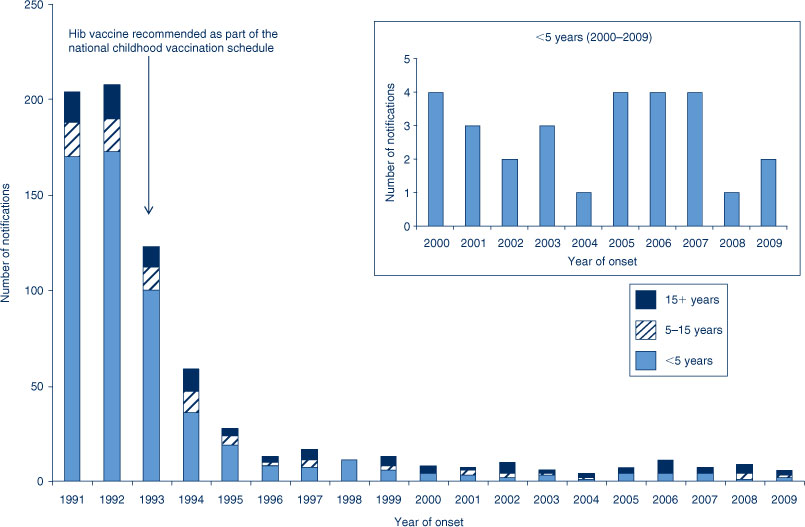NSW Annual Vaccine-Preventable Disease Report, 2009
Paula J. Spokes A B and Robin E. Gilmour AA Communicable Diseases Branch, NSW Department of Health
B Corresponding author. Email: pspok@doh.health.nsw.gov.au
NSW Public Health Bulletin 21(10) 197-209 https://doi.org/10.1071/NB10047
Published: 18 November 2010
Abstract
Aims: To describe trends in case notification data for vaccine-preventable diseases in NSW for 2009. Methods: Risk factor and vaccination status data was collected from cases through public health unit follow-up. Data from the NSW Notifiable Diseases Database were analysed by: area health service of residence; age; vaccination status; and sub-organism, as appropriate for the period 1991–2009. Results: The incidence of vaccine-preventable disease has declined over time. Outbreaks of measles and pertussis occur in the community, associated with unimmunised groups (measles) or as a result of waning immunity (pertussis). Conclusion: Regular reporting of vaccine-preventable disease surveillance data will help inform control strategies in NSW.
This is the first in what is planned to be a series of annual reports on vaccine-preventable disease surveillance in New South Wales (NSW). The objectives of vaccine-preventable disease surveillance are to: detect and investigate outbreaks of vaccine-preventable disease; identify close contacts of patients who may be at risk of infection; identify cases of possible vaccine failure; and understand the epidemiology of vaccine-preventable disease (including the impact of immunisation) to inform the development of prevention strategies.
Cases of vaccine-preventable disease were defined according to national criteria.1 Under the NSW Public Health Act 1991, since 1991: medical practitioners have been required to notify patients diagnosed with measles and pertussis; laboratories have been required to notify patients diagnosed with measles, pertussis, rubella, Haemophilus influenzae type b, meningococcal disease, mumps and rubella; and hospital general managers have been required to notify patients diagnosed with measles, pertussis, invasive pneumococcal infections (since 2002), Haemophilus influenzae type b and meningococcal disease, to NSW Health (via public health units).
Notifications of Haemophilus influenzae type b, measles, meningococcal disease, pertussis, pneumococcal disease (people aged less than 5 years and 50 years and over) and tetanus prompt public health follow-up according to NSW case definitions and response protocols.2 Notifications of mumps and rubella are not routinely followed-up by public health units in NSW.2 Public health unit staff enter data gathered on notified cases into the statewide Notifiable Diseases Database. This report describes trends in surveillance data for vaccine-preventable diseases in NSW.
Method
Notification data from the NSW Notifiable Diseases Database were reviewed for cases of vaccine-preventable diseases with a date of onset from 1991 to 2009. All rates were calculated using Australian Bureau of Statistics population estimates for the relevant year. Rates are presented as annual rates per 100 000 total population or population in age groups. Risk factor and vaccination status data was collected from cases through public health unit follow-up. In NSW, laboratories provide serotype data for measles, meningococcal and pneumococcal disease. Cases were analysed by place of usual residence according to geographical regions served by the relevant area health service public health unit.3
Results
Haemophilus influenzae serotype b
Haemophilus influenzae serotype b (Hib) is a bacillus which may be part of the flora of the upper respiratory tract. The bacteria are spread through contact with droplets from the nose or throat of an infected person, in household-like settings. Infection can result in invasive disease including meningitis, epiglottitis, septic arthritis, cellulitis and pneumonia.4 Since 1993, vaccination against Hib has been available and is provided for infants at 2, 4, 6 and 12 months of age.5
Summary of notified cases
The number of notified cases of Hib has decreased significantly in NSW since the introduction of a vaccine, from 124 in 1993 to six in 2009 (Figure 1). In 2009 two cases were aged less than 12 months, one case was aged 14 years and the remaining cases were aged between 40 and 65 years. Two cases were female and four were male. There were no notified cases of Hib in Aboriginal people in 2009.
Vaccination status
Of the six notified cases of Hib in 2009, three were unvaccinated (all adults), one case was fully vaccinated, one case was fully vaccinated for their age group and one case was too young to be vaccinated.
Comment
Hib is now rarely seen in Australian children. Children aged 6–7 months remain most vulnerable to Hib, until they can acquire their own natural immunity around the age of 2 years. Hib vaccination has successfully reduced the rate of disease in vaccinated children, reducing disease incidence in unvaccinated populations.
Measles
Measles is an acute, highly infectious viral disease that can have serious complications. Prodromal symptoms of measles include fever, tiredness, cough, runny nose, sore red eyes and feeling unwell. A characteristic rash appears 3–7 days after the prodrome, beginning on the face and spreading down the body. The rash usually lasts 4–7 days.4
Summary of notified cases
In 2009, 19 cases of measles were notified in NSW, compared to 39 in 2008 (Figure 2). Two were unvaccinated infants aged less than 12 months, two were aged 5–9 years, six were aged 10–19 years and nine were aged 20–40 years. Ten cases were female and nine were male. No cases were reported from Aboriginal people in 2009. The highest notification rates were reported from Central Sydney in the Sydney South West Area Health Service (1.4 per 100 000 population) (Table 1).

|

|
Vaccination status
Five cases were unvaccinated and for seven cases the vaccination status was unknown. Of the seven cases that reported previous vaccination, four had received one dose, one reported two doses, and for two the number of doses was unknown.
Outbreaks
Most notified cases of measles in NSW are reported in non-immune travellers who return with the infection from countries where measles is endemic or in non-immune people who are exposed to a known case.6 Of the 19 cases, 11 (58%) were associated with overseas travel, five (26%) were secondary contacts of overseas travellers, and for three (16%) the source was unknown (Figure 3). In 2009, one cluster of measles in metropolitan Sydney (involving six cases) was associated with a secondary school trip to Vietnam.
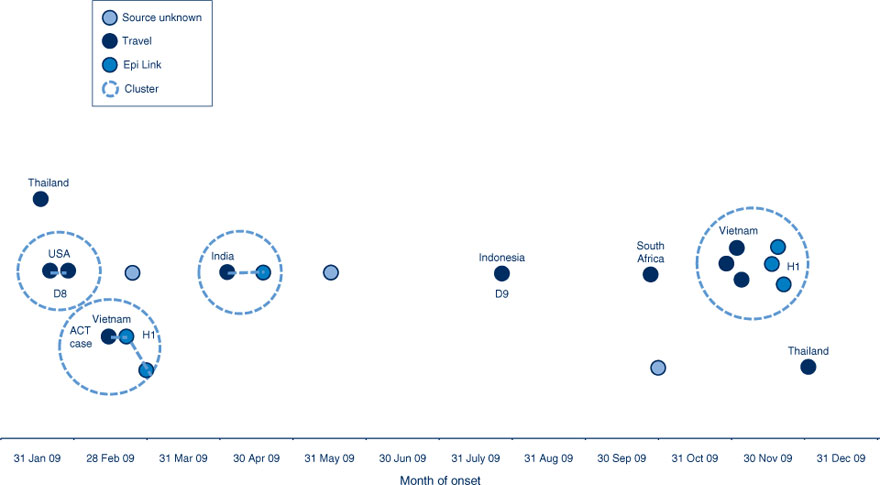
|
Genotype
There are several different genotypes of the measles virus. In 2009, five cases had measles genotype information identified. Of these, three were identified as H1 (associated with travel to Vietnam), one was D8 (associated with travel to the United States), and one was D9 (associated with travel to Indonesia) (Figure 3).
Comment
In the past, measles infection was very common in childhood. People at risk of contracting measles are those who have never had measles or who have never been vaccinated. A second dose of measles-mumps-rubella (MMR) was added to the National Immunisation Program in 1992.5 Non-immune travellers who return with the infection from countries where measles is endemic or non-immune people who are exposed to a known case make up the majority of notifications in NSW.
Meningococcal disease
Meningococcal disease is an acute bacterial disease that typically causes septic shock or meningitis (or a combination of these syndromes).4 Meningococcal disease is caused by infection with meningococcus bacteria, of which here are several serogroups. A vaccine against serogroup C meningococcal disease was added to the National Immunisation Program in 2003 for children at 12 months of age and offered to all persons aged 1–19 years between 2003 and 2004.5 There is no vaccine licensed in Australia to protect against disease caused by other serogroups.
Summary of notified cases
In 2009, 91 cases of invasive meningococcal disease were notified in NSW (80 confirmed and 11 probable). Eighty cases were reported in 2008 and 108 in 2007. The greatest reduction in notified cases of meningococcal disease has been for serogroup C, from 28% (n = 44) of known serogroup cases in 2003 to 9% (n = 7) in 2009 (Figure 4). Four deaths were reported in 2009 (two serogroup B, one serogroup W135, and one with an unknown serogroup) compared to three deaths in 2008 (all serogroup B). Eight cases were reported in Aboriginal people in 2009.
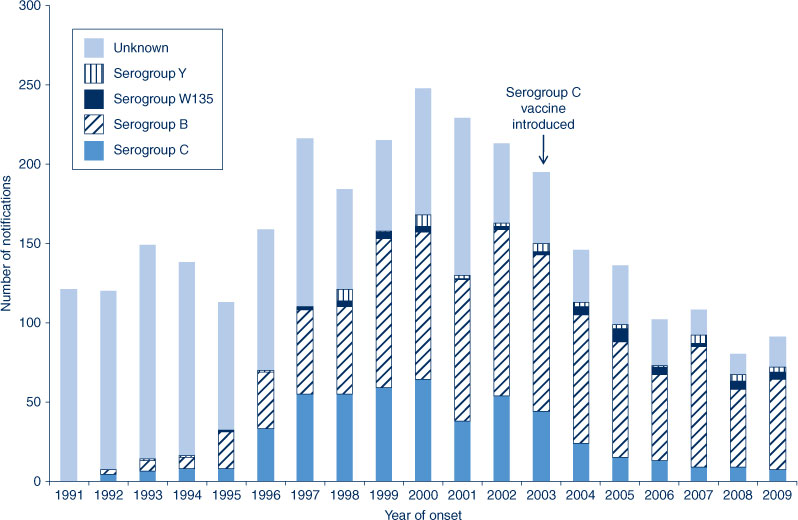
|
The highest notification rates of meningococcal disease were reported among children aged less than 5 years of age at onset of illness (29 cases, 6.2 per 100 000 population) and young people aged 15–19 years (21 cases, 4.4 per 100 000 population). Of the notifications from children aged less than 5 years, the highest rates were reported from infants aged less than 12 months (12 cases, 13.3 per 100 000 population) (Figure 5). Geographically, the highest notification rates were reported from Central Sydney in the Sydney South West Area Health Service (1.4 per 100 000 population) (Table 1).
Vaccination status
Vaccination status was complete for 84 cases (92%). Of these, 43 were vaccinated against serogroup C. Of the vaccinated cases, 31 (74%) were serogroup B, one was serogroup W135, one was serogroup Y, eight were unknown serogroup and one was serogroup C (an apparent vaccine failure).
Serogroup
Of the 91 cases notified in NSW in 2009, serogroup information was recorded for 74 (81%). In 2009, 59 (80%) cases with known serogroup information were caused by serogroup B (for which there is no vaccine), seven (9%) were serogroup C, five (7%) were serogroup W135 and three (4%) were serogroup Y. Of the 17 (19%) cases with unknown serogroup information, for eight the serogroup could not be typed and six were clinical diagnoses.
Comment
The number of notified cases of invasive meningococcal disease has declined significantly since the National Meningococcal C Immunisation Program commenced in 2003. Serogroup C meningococcal disease is now mainly seen in adults and unimmunised children. Meningococcal disease associated with serogroup B has also decreased (although not to the extent of serogroup C disease) and non-vaccine serogroups (W135 and Y) have remained relatively stable over time.
Mumps
Mumps is an acute infectious disease caused by the mumps virus. Common symptoms of mumps include fever, loss of appetite, tiredness and headaches followed by swelling and tenderness of the salivary glands. Illness is usually more severe in people infected after puberty.4 In NSW, vaccination is provided using MMR vaccine at 12 months and 4 years of age.5
Summary of notified cases
In 2009, 39 cases of mumps were notified in NSW compared to 76 in 2008 and 318 in 2007 (Figure 6). The highest numbers of cases were reported among young adults aged 20–29 years at onset of their illness (10 cases, 1.0 per 100 000 population). Males made up 62% of cases. The highest rates were reported from Central Sydney in the Sydney South West Area Health Service (1.1 per 100 000 population) and Northern Rivers in the North Coast Area Health Service (1.0 per 100 000 population).

|
Vaccination status
Notified cases of mumps are not routinely followed-up by public health units in NSW to determine vaccination status. As a result, vaccination status was complete for 10 (26%) cases in 2009.
Comment
In NSW, notified cases of mumps are not routinely followed-up by public health units. A significant increase in mumps notifications (largely from young adults in South Eastern Sydney in the South Eastern Sydney Illawarra Area Health Service) was reported in 2007.7 Notifications have since returned to baseline levels with no outbreaks or clusters reported in 2009.
Pertussis
Pertussis (or whooping cough) is a disease caused by infection of the throat with the bacteria Bordetella pertussis. Pertussis can be very serious in small children. Older children and adults may have a less serious illness, with bouts of coughing that continue for many weeks regardless of treatment.4 Pertussis vaccination is combined with diphtheria and tetanus (DTPa) in a primary course at 2, 4 and 6 months of age and a booster at 4 years of age. A second booster dose is given between 15 and 17 years of age using the adult dTpa formulation.5
Summary of notified cases
In 2009, 12 578 cases of pertussis were notified in NSW compared with 8759 in 2008 and 2100 in 2007. While epidemics of pertussis occur every 3–5 years,8,9 the number of cases notified in 2008 and 2009 far exceeded previous epidemic years (Figure 7). The number of notified cases peaked during the first quarter (5497) and declined in the last quarter of 2009 (1823).
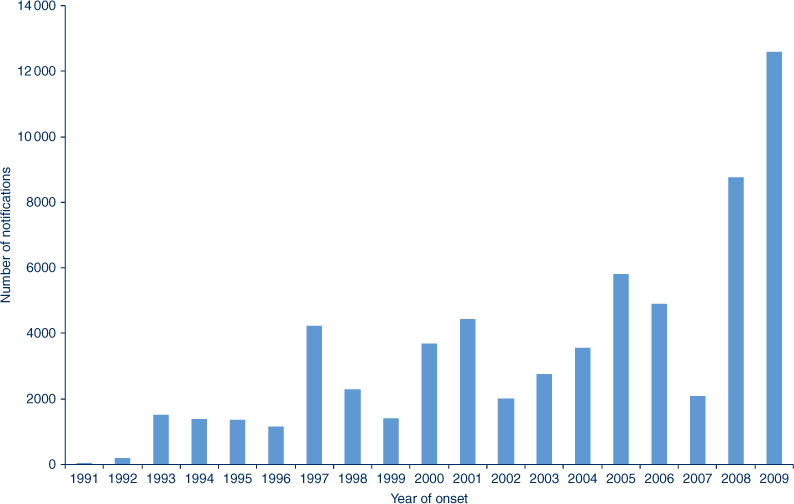
|
The highest pertussis notification rates were reported from children aged less than 5 years (2826 cases, 623.5 per 100 000 population) and 5–9 years (2653 cases, 598.4 per 100 000 population). Of the cases aged less than 5 years, the highest notification rates were reported from children aged 3 years (807.0 per 100 000 population) and infants aged less than 12 months (713.5 per 100 000 population) (Figure 8). The highest notification rates were reported from Illawarra in the South Eastern Sydney Illawarra Area Health Service (363.3 per 100 000 population) and Northern Rivers in the North Coast Area Health Service (278.3 per 100 000 population) (Table 1).
Vaccination status
In 2009, 2426 (85.8%) notified cases of pertussis in children aged 0–4 years had complete immunisation status data. Of these, 423 (17%) were unimmunised or partially immunised infants aged less than 12 months.
Method of diagnosis
Prior to the 2008–2009 epidemic the majority of pertussis cases notified in NSW were identified through serological testing, largely for people aged 20 years and over. During 2008 there was an increase in the use of polymerase chain reaction testing for pertussis diagnoses by laboratories across all age groups. Diagnoses by polymerase chain reaction testing accounted for 83% of pertussis cases notified in 2009.
Comment
The number of notified cases of pertussis increased significantly in the second half of 2008 and peaked during the first quarter of 2009. In 2009, the number of cases in children aged 1–4 years increased dramatically and in disproportion to previous years. This was particularly striking for children aged 3 years at onset of illness; 82% (of those with complete vaccination data) were reported to have received the full primary course (three doses) of vaccine, but had not received the 4-year booster dose. One reason for the increase in cases from the 3–4 year age group may be associated with waning immunity prior to the first booster dose recommended at 4 years of age.
There has been a significant shift in diagnostic testing practices by laboratories for pertussis in NSW from serology to the more sensitive polymerase chain reaction. In addition, the cut-off levels for a commonly used serological test changed across NSW. As a result, it may be difficult to compare 2008 and 2009 data with previous epidemic years.
Pneumococcal disease (invasive)
Pneumococcal disease is caused by infection with the bacteria Streptococcus pneumonia and is a frequent cause of serious bacterial infections.4 There are more than 90 different serotypes that can cause the disease. Vaccines for children aged less than 5 years (7-valent pneumococcal conjugate vaccine – 7vPCV) and adults older than 65 years (23-valent pneumococcal polysaccharide vaccine – 23vPPV) were introduced into the National Immunisation Program in 2005.5 In NSW, cases aged 5–49 years are not routinely followed-up by public health units.
Summary of notified cases
The number of notified cases of invasive pneumococcal disease has declined significantly since 2005 (Figure 9). In 2009, 480 cases of invasive pneumococcal disease were reported in NSW (6.8 per 100 000 population). The highest notification rates of invasive pneumococcal disease were reported in adults aged more than 80 years (29.2 per 100 000 population) and children aged less than 5 years (16.6 per 100 000 population) (Figure 10). Of the cases aged less than 5 years, the highest notification rates were reported in infants aged less than 12 months (30.0 per 100 000 population) and children aged 1 year (19.9 per 100 000 population). Geographically, the highest notification rates were reported from the Central Coast in the Northern Sydney Central Coast Area Health Service (11.8 per 100 000 population) and the Hunter in the Hunter New England Area Health Service (10.9 per 100 000 population) (Table 1). Aboriginal status was complete for 82% of cases and 11 cases were reported from Aboriginal people (data is incomplete for cases aged 5–49 years). Fifty-three deaths were reported in adults aged 50 years and over. There were no deaths reported in children.
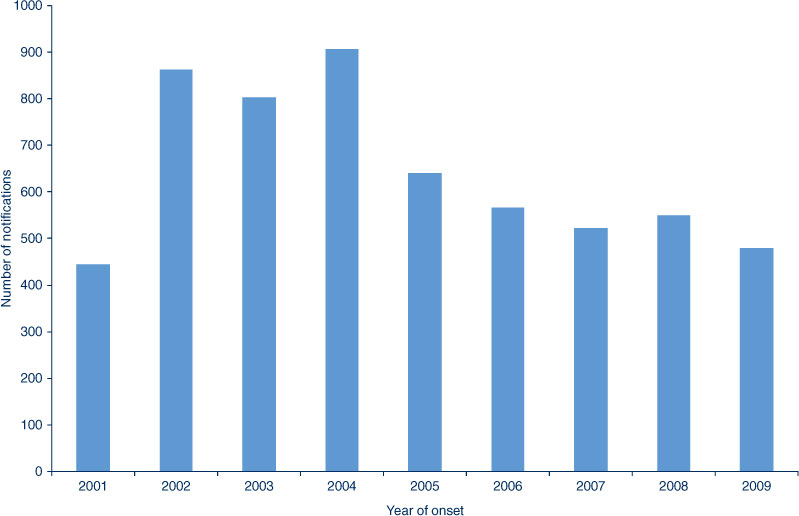
|
Serotype
Of the 480 cases of invasive pneumococcal disease notified in 2009, 445 (93%) had complete serotype information. In children aged less than 5 years with known serotype information, five (8%) had disease caused by a vaccine-related serotype 19F. The majority of invasive pneumococcal disease in children is caused by serotypes not covered by the 7-valent vaccine, particularly serotype 19A which accounted for 39 (52%) cases. In adults aged 50 years and over, 71 (28%) cases were caused by a non-vaccine-related serotype. However, serotype 19A, which is included in the adult vaccine, accounted for 67 (26%) notifications.
Antibiotic susceptibility
Penicillin resistance was reported in 22% of cases aged less than 5 years and 11% of cases aged 50 years and over. Serotype 19A accounted for 79% of penicillin-resistant serotypes in cases aged less than 5 years and 69% in cases aged 50 years and over.
Vaccination status
Of the 75 notified cases from children aged less than 5 years, 63 (84%) were fully vaccinated. Of these, three (5%) were vaccine failures from serotype 19F, 54 (86%) were from serotypes not included in the current vaccine and in six (10%) cases the serotypes were unknown.
Of the 280 notified cases from adults aged 50 years and over, 59 (21%) were fully vaccinated. Of these, 33 (56%) were from serotypes included in the vaccine, 24 (41%) were from serotypes not included in the current vaccine and in two (3%) cases the serotypes were unknown.
Comment
Invasive pneumococcal disease has significantly decreased in children under the age of 5 years, with moderate decreases in adults aged 50 years and over following the inclusion of pneumococcal vaccines (7vPCV and 23vPPV) into the National Immunisation Program in 2005.10 In children especially, disease caused by serotypes included in the 7-valent vaccine are uncommon, however, replacement invasive disease (disease caused by serotypes not included in the 7vPCV vaccine) has been increasing in recent years (particularly disease caused by serotype 19A). Furthermore, penicillin resistance – which has been relatively stable in NSW for the past 10 years – has significantly increased in the last 2 years. Previously, resistance in NSW primarily occurred in serotypes 9V and 19F (serotypes covered by the 7vPCV vaccine) (Gilmour R, unpublished data, 2010). Since the introduction of the 7vPCV vaccine in NSW, these serotypes rarely if at all occur and, therefore, penicillin resistance has been low. In both 2008 and 2009, penicillin resistance in children aged less than 5 years in NSW was at the highest levels recorded since data collection began in 1997: serotype 19A contributes to 79% resistance in children aged less than 5 years and 69% resistance in adults aged 50 years and over.
Rubella
Rubella (or German measles) is an infectious viral disease. Although a mild infection in most people, infection in early pregnancy can cause serious birth defects or miscarriage. Rubella is spread from an infected person by droplets from the nose or mouth or by direct contact.4 Rubella is easily spread to people who have not been vaccinated or previously infected. Rubella vaccination is provided using MMR vaccine at 12 months and 4 years of age.5
Summary of notified cases
In 2009, seven cases of rubella were notified in NSW compared to 17 in 2008. The number of notified cases of rubella has remained stable since 2005 with an average of 18 cases reported annually. The highest notification rates were reported among young adults aged 25–29 years (0.6 per 100 000 population). In 2009, three (43%) cases were female. The highest rates were reported from North Sydney in the Northern Sydney Central Coast Area Health Service (0.2 per 100 000 population) (Table 1).
Comment
Notifications of rubella are not routinely followed-up by public health units in NSW. Notification trends for rubella are similar to those observed for measles and mumps, with cases generally declining over time.11
Tetanus
Tetanus (sometimes called lock-jaw) is a disease caused by the bacteria Clostridium tetani. Toxin made by the bacteria, which grows at the site of an injury, attacks a person’s nervous system. Although now rare due to immunisation, tetanus can be fatal. C. tetani bacteria are found in dust and animal faeces and infection may occur after minor injury (sometimes unnoticed punctures to the skin that are contaminated with soil, dust or manure) or after major injuries such as open fractures, dirty or deep penetrating wounds, and burns.4 Tetanus is not passed from one person to another. Vaccination against tetanus is given to children with diphtheria and pertussis (DTPa) in a primary course at 2, 4 and 6 months of age. A booster dose of DTPa is given at 4 years.5 A second booster dose has been included in the National Immunisation Program for those aged 15–17 years since 2004 using the adult dTpa formulation.
Summary of notifications
In 2009, one case of tetanus was notified in NSW. The man, aged in his thirties, reported symptoms after standing on a nail.
Comment
The numbers of notified cases of tetanus have remained relatively stable over the past 5 years, ranging from one to two cases annually. In Australia, tetanus mostly occurs in older adults who are not adequately immunised.
Discussion
The numbers of notified cases of most vaccine-preventable diseases reported in NSW is low although occasional outbreaks do occur. In NSW, outbreaks of vaccine-preventable disease are usually the result of non-vaccinated people travelling to countries where vaccine-preventable disease is more common, as was the case in the measles outbreak where 84% of cases reported in NSW had either travelled overseas or had had contact with someone who had recently travelled overseas.
Epidemics of vaccine-preventable disease occur from time to time. For pertussis, outbreaks occur every 3–4 years and are thought to be the result of waning immunity, particularly in adults and adolescents who become a significant reservoir for infection. Ongoing review of vaccines and vaccination schedules is paramount in preventing vaccine-preventable disease.
The data derived from notifications of vaccine-preventable disease are subject to several limitations. Notification data are likely to underestimate the true number of cases of disease for two reasons. Firstly, many infections can be mild, so people may not present for medical attention. For those who do present, notification relies on a diagnosis being made and appropriate laboratory tests being ordered. Secondly, positive diagnoses may not be notified by the doctor, laboratory or hospital to public health units as required under the Public Health Act for a variety of reasons. Nonetheless, assuming these biases are relatively stable over time, vaccine-preventable disease notification data do provide a useful indication of the trends in disease incidence in NSW.
Conclusion
The current low numbers of notified cases of most vaccine-preventable diseases in NSW is largely the result of reaching and maintaining high vaccination coverage levels. Reporting and disease estimates from surveillance systems can be affected by changes in disease awareness, laboratory diagnostic tests and testing protocols, case definitions, and reporting practices over time. However, ongoing surveillance for vaccine-preventable disease is important to identify changes to disease incidence and to inform appropriate public health action.
Acknowledgments
The authors would like to thank and acknowledge the NSW public health network, including laboratory staff, for their work in identifying and managing cases of vaccine-preventable disease in NSW.
[1]
[2]
[3]
[4]
[5]
[6] Brotherton J. EpiReview: Measles in NSW, 1991–2000. N S W Public Health Bull 2001; 12(7): 200–4.
| Crossref | GoogleScholarGoogle Scholar | PubMed |

[7] Ferson MJ, Konecny P. Recent increases in mumps incidence in Australia: the ‘forgotten’ age group in the 1998 Australian Measles Control Campaign. Med J Aust 2009; 190(5): 283–4.
| PubMed |

[8] Viney KA, McAnulty JM, Campbell-Lloyd S. EpiReview: Pertussis in New South Wales, 1993–2005: the impact of vaccination policy on pertussis epidemiology. N S W Public Health Bull 2007; 18(3–4): 55–61.
| Crossref | GoogleScholarGoogle Scholar | PubMed |

[9] Spokes PJ, Quinn HE, McAnulty JM. Review of the 2008–2009 pertussis epidemic in NSW: notifications and hospitalisations. N S W Public Health Bull 2010; 21(7–8): 167–73.
| Crossref | GoogleScholarGoogle Scholar | PubMed |

[10] Gilmour R. EpiReview: Invasive pneumococcal disease, NSW, 2002. N S W Public Health Bull 2005; 16(1–2): 26–30.
| Crossref | GoogleScholarGoogle Scholar | PubMed |

[11] Brotherton J, Habib M. EpiReview: Rubella in NSW 1991–2000. N S W Public Health Bull 2001; 12(3): 85–7.
| Crossref | GoogleScholarGoogle Scholar | PubMed |



